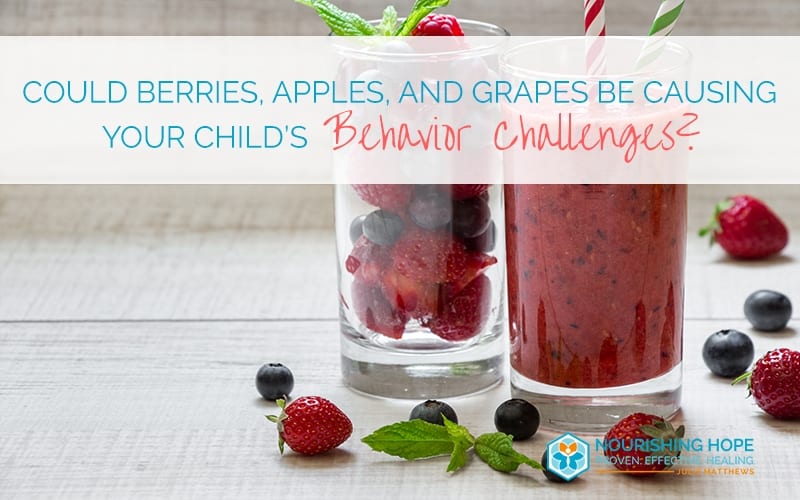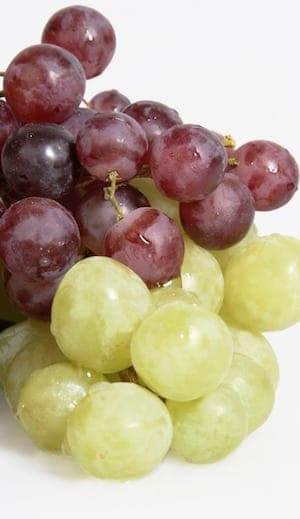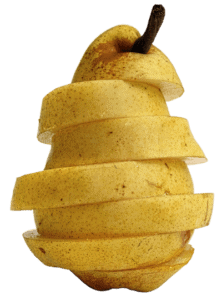
What do berries, apples, and grapes have in common?
Salicylates.
A vast majority of children with autism and ADHD in my nutrition practice have salicylate reactions. The most common symptoms are red cheeks. red ears, hyperactivity, and irritability..
SALICYLATES are a #1 food related cause of BEHAVIOR issues.
There is a reasonable explanation for the prevalence I see in my practice. It’s not just because I am aware of reactions and so I recognize more than the average nutritionist, although that is true too.
It is because there are underlying factors and biochemistry that can cause an inability to process these food compounds and has such, reactions are common.
The good news is that there are things you can do.
What are Salicylates?
Salicylates are naturally-occurring food chemicals in fruits, vegetables, and other plant foods like herbs, spices, nuts, etc.). In the 1950’s and 60’s, Dr. Ben Feingold observed that artificial additives and high salicylate foods caused hyperactivity and other symptoms in some children. Biochemically, salicylates are a type of “phenolic acid” or “phenol.” Phenols need to be broken down in the body, i.e. “detoxified,” which occurs through a process called sulfation.
Salicylates to Avoid
Fruits (most fruit is high)
- Grapes
- Strawberries
- Blueberries
- Raspberries
- Most melons including watermelon
- Peaches
- Nectarines
- Plums
- Apples
Vegetables
- Red bell peppers
- Cucumbers and pickles
- Tomato sauce and ketchup (technically a fruit)
- Spinach
- Zucchini (with the peel on)

Herbs and spices
- Cinnamon
- Cloves
- Rosemary
- Thyme
- Turmeric
- Ginger
Additional high salicylate foods
- Almonds
- Honey
These fruits are delicious and plentiful, children eat quite a bit more during summer than any other time. The resulting increase in salicylate consumption can cause a child’s body to become overloaded, and cause physical, emotional, and behavioral symptoms.
Symptoms of Salicylates
Symptoms vary by individual, but some of the most common salicylate sensitivity symptoms are:
- Red cheeks and ears (not from the heat)
- Hyperactivity
- Irritability
- Defiant behavior
- Aggression toward self or others
- Overly emotional/crying
- Bedwetting and day-wetting accidents
- Sleeping challenges
Artificial Additives
Junk food with artificial additives are more plentiful during summer. Artificial additives such as artificial colors, flavors and preservatives are strong phenols–and require the same biochemical processes.
If you don’t consume these, good for you. You shouldn’t.
In the average American family, however, blue-colored sports drinks on hot days, cotton candy from the beach boardwalk or fair, shaved ice or blended slushies from the amusement park are all to common occurrences (sadly). Alone they are known to cause hyperactivity, combined with these other stressors and they can be particularly problematic.
Underlying Contributors and Biochemistry
Inadequate sulfation is the underlying biochemical issue in salicylate intolerance. This can be due to depletion of sulfate from sources such as food or a pathogen. It can be due to inadequate supply. Or the kidneys can dump sulfate, wasting it.
Without proper sulfate we cannot have proper sulfation. Sulfation handles many processes such as sealing up the gut so it’s not leaky. And detoxifying chemicals and processing salicylates and phenolic compounds.
Poor sulfation, and salicylate reactions, are common in autism and ADHD.
Salicylates can mask your GFCF Success
A very common scenario is that a family will go gluten-free and dairy-free, typically a great choice. And then start eating more healthy foods. But instead of feeling better the child has just as many, if not more, reactions and behavior issues than before.
Sadly, parents often think this means the diet is not working or wrong for them. However, that’s an incorrect assumption most of the time.
What’s usually going on is that the salicylate reactions mask the GFCF diet success. When they reduce salicylates the symptoms go away and they see the benefit they had been hoping for from dietary intervention.
Experience from a Mom…
 “I was at a conference listening to nutritionist Julie Matthews. She was showing a slide of various behaviors, pretty accurately describing my son. At that time, my son had started showing some aggressive behaviors, mostly directed towards me (biting, causing bruises), and I was getting phone calls from school about him lashing out. The follow up slide was which foods to eliminate in order to stop the behaviors. It was all of my son’s favorites. I immediately texted my husband and told him, when I got home, we were doing a diet overhaul. We took out all of the problem foods, and his behaviors stopped! The change was so dramatic that his doctor, who had wanted to start medication, decided it was unnecessary. Do not discount diet!”
“I was at a conference listening to nutritionist Julie Matthews. She was showing a slide of various behaviors, pretty accurately describing my son. At that time, my son had started showing some aggressive behaviors, mostly directed towards me (biting, causing bruises), and I was getting phone calls from school about him lashing out. The follow up slide was which foods to eliminate in order to stop the behaviors. It was all of my son’s favorites. I immediately texted my husband and told him, when I got home, we were doing a diet overhaul. We took out all of the problem foods, and his behaviors stopped! The change was so dramatic that his doctor, who had wanted to start medication, decided it was unnecessary. Do not discount diet!”
-Jennifer S.
What can you do?
Avoid Junk Food
Firstly, if your child eats artificial additives, cut them all out. It’s the first step of my Nourishing Hope for Healing Kids nutrition program. And it can be a simple, yet tremendously helpful step.
Look for Reactions
If you want to determine a food intolerance to salicylates, you might start by simply observing your child within the hour after they eat, and before bedtime—making correlations with high salicylate consumption. The best way to determine salicylate intolerance is to avoid high salicylate foods for a period of time and observe any improvements, and then add them back and see if you notice a reaction.
What to Eat
There are two diets that I like that address this: The Feingold Diet and The Failsafe Diet. The Feingold Diet is a smaller list of salicylates to avoid—it includes many of the big offenders (but misses some) and is easier to do. The Failsafe diet is much more comprehensive, but more complex and restricts more foods. And at Nourishing Hope, we have our own list that I created from 17 years of working with this diet with my clients.
Below are some of my favorite low salicylate replacements to eat.
 Fruit:
Fruit:
- Pears
Vegetables:
- Brussels Sprouts
- Butternut Squash
- Celery
- Green Beans
- Lettuce (head)
- Rutabagas
Nuts:
- Cashews
Herbs, Spices. and Seasoning:
- Chives
- Green onions
- Vanilla
- Salt
Most meats, grains, and beans/legumes are low salicylate.
Do a Dietary Trial
Try taking these foods out of your child’s diet for a few weeks and see what happens. Do you notice improvement? Which symptoms have gone away? Record what your child is eating and what you are noticing. You can do a dietary provocation, adding foods back to see if the reaction returns.
Add Back Allowed Foods
And remember you don’t want to overly restrict a diet, so add back any foods that are not causing a reaction. There are testing phases to the diet to help you determine: 1) if salicylates are causing a problem, 2) what your child’s threshold is.
And get support so your child has a healthy diet while on this diet. Make sure you find a practitioner that can address the underlying factors so you can go back to eating a more variety diet in time.
Epsom salt baths
You can also try Epsom salt (magnesium sulfate) baths or magnesium sulfate cream—the sulfate absorbs and helps supply sulfate for sulfation/detoxification. This can help a child process the salicylates better, and reduce reactions from salicylates.
Support
To learn more on whether a low salicylate diet is right for your child and for tools on how to implement it easily and effectively, check out my Nourishing Hope for Healing Kids nutrition program for parents.


